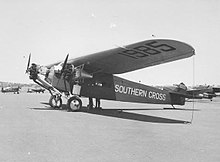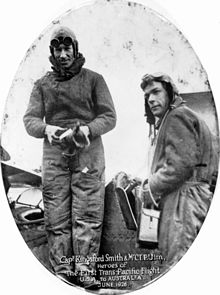
Sir Charles Edward Kingsford Smith, nicknamed Smithy, was an Australian aviation pioneer. He piloted the first transpacific flight and the first flight between Australia and New Zealand.

China Clipper (NC14716) was the first of three Martin M-130 four-engine flying boats built for Pan American Airways and was used to inaugurate the first commercial transpacific airmail service from San Francisco to Manila on November 22, 1935. Built at a cost of $417,000 by the Glenn L. Martin Company in Baltimore, Maryland, it was delivered to Pan Am on October 9, 1935. It was one of the largest airplanes of its time.
This is a list of aviation-related events from 1935:

Edwin Charles Musick was chief pilot for Pan American World Airways and pioneered many of Pan Am's transoceanic routes including the famous route across the Pacific Ocean, ultimately reaching the Philippine Islands, on the China Clipper.
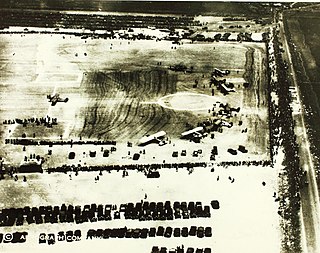
The Dole Air Race, also known as the Dole Derby, was a deadly air race across the Pacific Ocean from Oakland, California to Honolulu in the Territory of Hawaii held in August 1927. There were eighteen official and unofficial entrants; fifteen of those drew for starting positions, and of those fifteen, two were disqualified, two withdrew, and three aircraft crashed before the race, resulting in three deaths. Eight aircraft eventually participated in the start of the race on August 16, with only two successfully arriving in Hawaii; Woolaroc, a Travel Air 5000 piloted by Arthur C. Goebel and William V. Davis, arrived after a 26 hour, 15 minute flight, leading runner-up Aloha by two hours.

The first aerial circumnavigation of the world was completed in 1924 by four aviators from an eight-man team of the United States Army Air Service, the precursor of the United States Air Force. The 175-day journey covered over 26,345 miles (42,398 km). The team generally traveled east to west, around the northern-Pacific Rim, through to South Asia and Europe and back to the United States. Airmen Lowell H. Smith and Leslie P. Arnold, and Erik H. Nelson and John Harding Jr. made the trip in two single-engined open-cockpit Douglas World Cruisers (DWC) configured as floatplanes for most of the journey. Four more flyers in two additional DWC began the journey but their aircraft crashed or were forced down. All airmen survived.

Smithy is a 1946 Australian adventure film about pioneering Australian aviator Sir Charles Kingsford Smith and his 1928 flight across the Pacific Ocean, from San Francisco, California, United States to Brisbane, Queensland, Australia. This was the first-ever transpacific flight. Kingsford Smith was the pilot of the Fokker F.VII/3m three-engine monoplane "Southern Cross", with Australian aviator Charles Ulm as the relief pilot. The other two crew members were Americans James Warner and Harry Lyon.

The Southern Cross is a Fokker F.VIIb/3m trimotor monoplane that was flown by Australian aviator Charles Kingsford Smith, Charles Ulm, Harry Lyon and James Warner in the first-ever trans-Pacific flight to Australia from the mainland United States, a distance of about 11,670 kilometres (7,250 mi), in 1928.

The Lady Southern Cross was a Lockheed Altair monoplane owned by Australian pioneer aviator Sir Charles Kingsford Smith.

Sir Patrick Gordon Taylor,, commonly known as Bill Taylor, was an Australian aviator and author. He was born at Mosman, Sydney, and died in Honolulu.
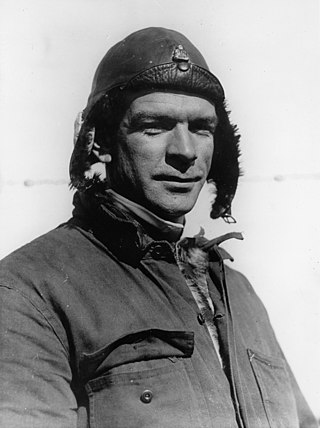
Charles Thomas Philippe Ulm was a pioneer Australian aviator. He partnered with Charles Kingsford Smith in achieving a number of aviation firsts, serving as Kingsford Smith's co-pilot on the first transpacific flight and the first flight between Australia and New Zealand. He and two others disappeared near Hawaii in 1934 while undertaking a test flight for an air service between Australia and the United States.
Keith Allison Virtue MBE was a pioneer Australian aviator. Sir Lawrence Wackett, in the foreword of Keith Virtue's biography, writes that he was an experienced airman himself but he marvelled at the ability and skill of Keith Virtue and counts him as one of the greatest of the Australians who devoted their life's work to the task of pioneering airlines in Australia.
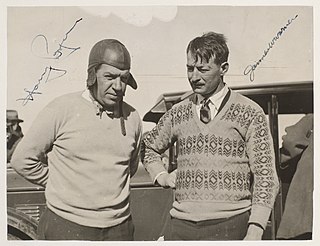
James Warner (1891–1970) was the radio operator on the aircraft Southern Cross piloted by Charles Kingsford Smith for the first trans-Pacific flight in 1928, during which radio was first used successfully on a long distance flight.

The China Clipper flight departure site is listed as California Historical Landmark number 968. It is the site from which Pan American World Airways initiated trans-Pacific airmail service on November 22, 1935. A flying boat named China Clipper made the first trip, and the publicity for that flight caused all flying boats on that air route to become popularly known as China Clippers. For a few years, this pioneering mail service captured the public imagination like the earlier Pony Express, and offered fast luxury travel like the later Concorde.

Larry Newman was an American pilot, business man, and balloonist. He was part of the balloon crews that made the first Atlantic ocean crossing by balloon in the Double Eagle II and the first Pacific ocean crossing by balloon in the Double Eagle V.
VPB-29 was a Patrol Bombing Squadron of the U.S. Navy. The squadron was established as Pacific Air Detachment on 17 January 1923, redesignated Patrol Squadron 14 (VP-14) on 29 May 1924, redesignated Patrol Squadron 1-Naval District 14 (VP-1D14) on 21 September 1927, redesignated Patrol Squadron 1-B (VP-1B) on 1 July 1931, redesignated Patrol Squadron 1-F (VP-1F) on 15 April 1933, redesignated Patrol Squadron 1 (VP-1) on 1 October 1937, redesignated Patrol Squadron 21 (VP-21) on 1 July 1939, redesignated Patrol Squadron 1 (VP-1) on 30 July 1940, redesignated Patrol Squadron 101 (VP-101) on 3 December 1940, redesignated Patrol Bombing Squadron 29 (VPB-29) on 1 October 1944 and disestablished on 20 June 1945.
Bert Ive (1875–1939) was a British-born Australian cinematographer, who was the first long-term cinematographer and still photographer in Australia. During his career as a film photographer for the federal government from 1913 to 1939, he frequently travelled across Australia to photograph the country's landscapes, industries, people and famous events. His motion pictures and still photos were used to promote Australia to the rest of the world.
Transpacific crossings are voyages of passengers and cargo across the Pacific Ocean between Asia, Oceania, and the Americas. Transpacific voyages frequently cross the International Date Line. The first recorded crossing of the Pacific was the Magellan-Elcano expedition of 1521. Commercial transpacific flights have been available since 1935.

Keith Vincent Anderson was an Australian pioneer aviator. In 1927 Anderson and his co-pilot, "Bobby" Hitchcock, undertook a round-Australia flight. Anderson and Hitchcock died in 1929, after a forced landing in the desert, during the search for Charles Kingsford Smith and his crew, who had been forced to land in Western Australia on the first leg of a flight in the Southern Cross aircraft to London.
